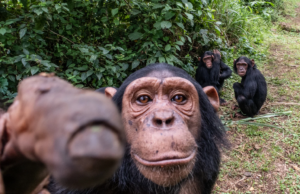GAP PROJECT, AFRICA – LOLA YA BONOBO SANCTUARY
GAP PROJECT,
LOLA YA BONOBO SANCTUARY
By Fernando Turmo, from
In 2002 it was created near
This sanctuary is called LOLA YA BONOBO, local language for "Bonobos Paradise". There, about 60 bonobos spend their days in big and full of trees spaces of 30 hectares, approximately. In the boundaries of the area there is an electric fence that avoids that the bonobos get lost. In the evening everyone enters in big bedrooms to take a rest.
Like other similar primates sanctuaries, LOLA YA BONOBO receives orphan bonobos who are confiscated or donated voluntarily. All the babies have a personal tragedy in common: their mothers were killed by gun shots, cut in pieces or cooked in front of them (the meat is sold in the city markets in great quantities). As a result, the babies are transported from one city to another by someone who is looking for a corrupt or a uninformed buyer, who wishes to gain status by having a luxury pet.
This story is not new, as long as bushmeat trade is rising very quickly in the last decades all over the world. Nevertheless, it\’s worth to point that it would be very sad if the species bonobo came to extinction in our planet without the knowledge of its existence. The great similarity with the common chimpanzee keeps them unknown. However, I think that bonobo is a primate with characteristics enough to be considered a distinct species.
Both chimpanzees and humans had a common ancestor six million years ago. With chimpanzees and bonobos something similar also happened three millions years ago. From this moment on their ways got separated and they became two different species.
About the physique, the differences are noted only by looking at them. Bonobos are thinner and more delicate than chimpanzees, and often the face is black and the lips, pink. Including the babies; differently from chimpanzees, bonobos have black faces since they are born. Bonobos have long hair on both sides of the face and the head. At the same time they have a larger chest, both the head and the ears are smaller.
All these characteristics, united to a stronger tendency to walk on two feet, give to bonobos a greater similarity to humans.
Apart from all that, bonobos have a great cognitive capacity. Two bonobos, Kanzi and Panbanisha (at Iowa Sanctuary) have learnt a vocabulary of 400 words and can write using a special keyboard of geometrical symbols. They also can answer to questions formulated by voice by their trainers.
In bonobo societies females are the dominants in the groups, a difference from chimpanzees. In spite of having social hierarchies, the position of each individual has not a very important role, as in other primates\’ societies. Nevertheless, the females have a stronger coalition and association capacity between them than with the males. As long as they are less strong than males, they compensate with a greater capacity of establish relationships between females, which make them more powerful to battle any aggression made by the other sex.
It\’s important to point out that sex is frequently used as social bond. The individuals tend to have sex regularly to ease tensions or just for pleasure. Everyone with everyone, small ones with adults, females with males or even females between them. There are not too many limits in the promiscuity level.
The difference between chimpanzees and bonobos is that they do not organize the hunting of small animals or other monkeys. Bonobos are almost exclusively vegetarians and occasionally they eat insects.
Currently it is being developed projects at Congo-Kinshasa that involve the native people on the protection of natural areas, to be controlled by them. In the past, the reserve areas created had too many problems of illegal hunting. This resulted in the banishing of these people from the lands, converting them in enemies. In the new model the population is part of the project and should be responsible for the administration of the area.
LOLA YA BONOBO has given the first steps to develop a historical Project of great relevance, as long as it will be the first time that bonobos are going to be reintroduced in their natural habitats. Claudine is signing an agreement with local communities that live in the reintroduction area where 25 bonobos are going to be released. This area is isolated, and can be accessed only by boat or plane, far away from the nine millions humans that live in
The negotiation was not easy. The commitment signed implies that the 3 villages around the reservation area are going to receive medical and educational assistance and are going to benefit from the visit of tourists, and a phone tower will be installed to allow them not to live isolated anymore.
Bonobos\’ souls are going to enrich the distant and mysterious home at the
Good luck, Madame Claudine, from GAP Project

 Español
Español
 Português
Português








